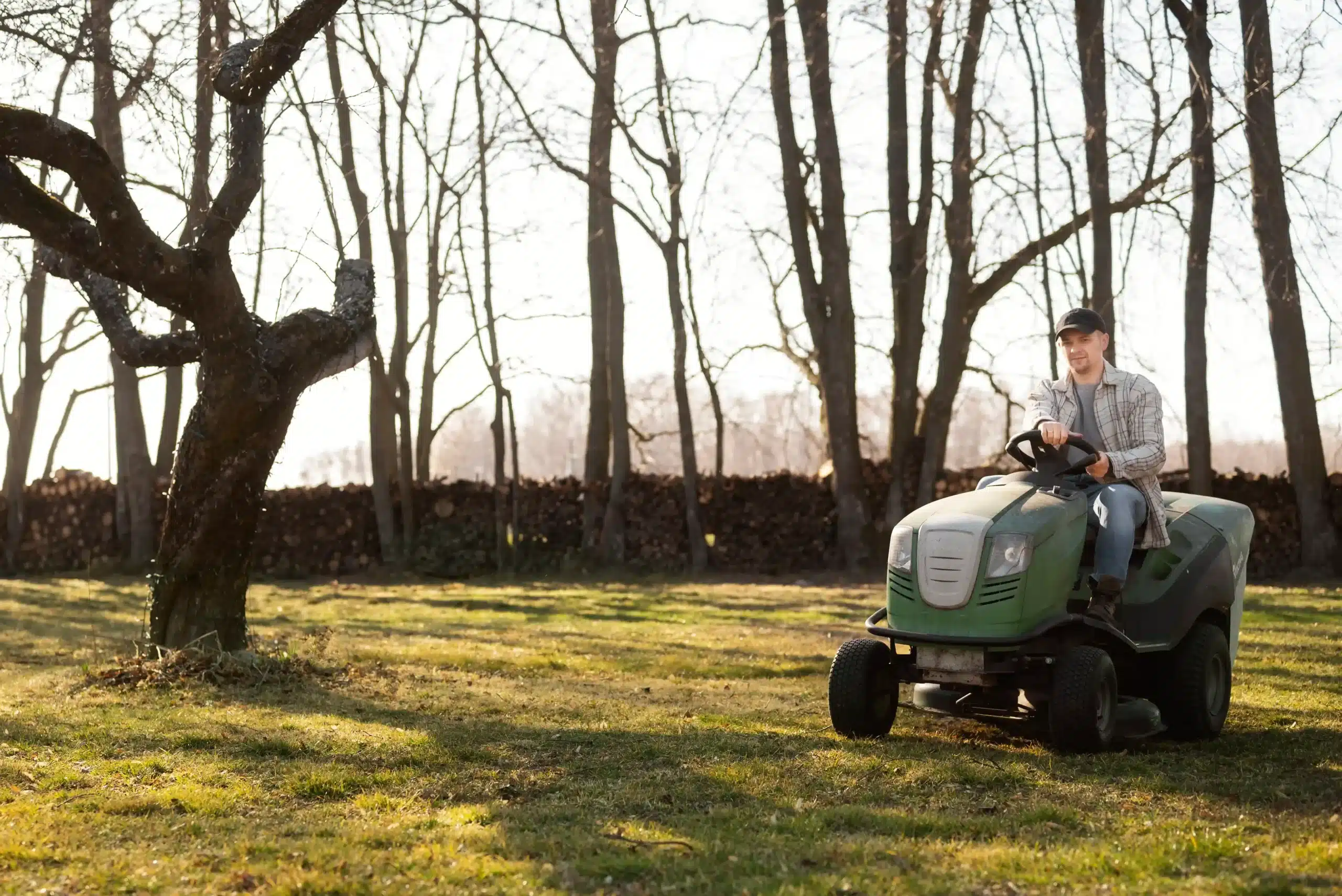
Riding lawn mowers are heavy and not built for easy transport. Without the right tools and a proper plan, moving a lawn mower can be risky. If you’re planning to transport a riding lawn mower, solid preparation goes a long way. This guide offers straightforward, practical steps to avoid damage and to do it safely. We’ll also cover the best way to transport a riding lawn mower without starting the engine.
Why It’s Important to Transport a Riding Lawn Mower Properly
Getting a riding mower from one place to another may seem easy, but doing it the wrong way can lead to serious problems. Here’s why proper transport matters.
- If you don’t load or secure a lawn mower correctly, you risk cracked parts, bent axles, or alignment issues that cost more than the move itself.
- These machines weigh hundreds of pounds. One slip while loading or unloading can cause serious injury.
- A loose mower in a trailer or a truck bed can dent the interior, damage suspension, or shift during transit, breaking other items.
- Some manufacturers require specific steps when moving the mower. If you skip them, you could void the warranty.
- In some states, there are laws about securing large equipment on public roads. Ignoring them could lead to fines or other legal liability if something goes wrong.
Essential Tools and Materials for Safe Lawn Mower Transport
Before transporting your riding mower, make sure you have the right tools on hand. The right gear makes the job safer, smoother, and a lot less stressful. Each item below plays a specific role in keeping both the mower and the people moving it protected during a move.
Loading Ramps
You’ll need strong, stable loading ramps rated for your mower’s weight. Choose ramps with side rails and a slip-resistant surface to prevent accidents. Aluminum folding ramps work well for most models, but heavier mowers like zero-turns may need steel ramps for better support. Make sure the ramp is long enough to create a gentle incline, which helps prevent the mower deck from scraping the ground.
Pickup Truck or Trailer
A pickup truck with a wide, open bed is fine for smaller riding mowers. For larger or heavier equipment, a flatbed trailer gives you more space and flexibility. The trailer must be in good condition, with working lights and, if required by your local transport laws, working brakes. Check the weight rating of the truck or the trailer to avoid overloading it.
Ratchet Straps
Once the mower is loaded, it needs to be fully secured. Use strong ratchet straps to anchor all four corners. Avoid bungee cords, since they stretch under tension and may snap during transit. A good tie-down system is especially important when you’re driving over rough or uneven ground.
Wheel Chocks
Wheel chocks help keep the mower from rolling while you’re securing it. Place them in front of and behind each tire to secure them. Putting chocks around all four tires results in better stability, especially on slopes or slick surfaces. Go for rubber or heavy-duty plastic versions, since they grip the ground better than wood and last longer.
Gloves and Safety Boots
Gloves help you keep a steady hold on the mower and the ramps. Choose gloves with padded palms that don’t slip. For your feet, wear something solid, like steel-toe boots or tough-soled shoes, in case the mower shifts while loading or unloading.
Parking Brake and Mower Key
Before loading the mower, activate the parking brake to keep it from moving. Remove the key to prevent the lawn mower from starting or causing an accident during the move.
Owner’s Manual
Your mower’s manual might include specific transport instructions for your model. Some manufacturers list warnings about how steep a ramp can be, how to secure it without bending the frame, or what features should be turned off before moving.
Prepping the Riding Mower Before Transport
Before you load up the mower, take a few minutes to prep it. This helps prevent damage during transport and makes loading safer. Run through the checklist below to get everything in order.
- Clean the mower: Clear away any built-up grass, dirt, or debris from the deck, wheels, and underside. This helps the mower stay steady while loading and keeps your vehicle cleaner.
- Remove accessories: Take off anything extra, like baggers or tow-behind tools. It’s safer to move them separately so nothing bends, breaks, or gets in the way while moving the mower.
- Check tire pressure: Soft tires make the mower harder to load and secure. Inflate them to the recommended level so the mower drives up the ramps smoothly and sits evenly once tied down.
Step-by-Step Instructions: How to Transport A Riding Lawn Mower
Once you have the gear and the mower is prepped, follow these steps to avoid mistakes, damage, and injury.
1. Choose the Right Vehicle or Trailer
The vehicle you choose to transport a riding mower should accommodate the mower’s size. A smaller model might fit in a pickup truck. For heavier models, a trailer is usually the safer choice. Always confirm that both the trailer and your vehicle can safely handle the load before moving forward to avoid any damage.
2. Position and Secure the Ramps
Set up the loading ramps on level ground and make sure they’re fully unfolded and locked into place. Secure them tightly to the edge of the trailer or the truck bed using the built-in safety chains or tie-down straps. Check that the ramp surface is clean and dry.
3. Drive the Mower Onto the Ramp
Start the mower and slowly drive it straight up the center of the ramp, using a spotter to guide you. Keep your speed low and avoid sudden turns. It’s not recommended to push a mower up the ramp without driving it, since it’s heavy and can cause injury. It’s also difficult to get sufficient leverage to roll up the mower safely.
4. Park and Secure the Mower
Once the mower is loaded, park it in the middle of the trailer or truck bed. Turn on the parking brake. Place wheel chocks around the tires. Then, use ratchet straps on all four sides and tighten them until the mower stays firmly in place.
5. Disconnect the Spark Plug
Pull the plug before you start moving the vehicle with the mower in it. Doing this prevents accidentally starting the mower and keeps your hands safe when working near the blades.
6. Empty or Seal the Fuel Tank
Drain the gas or seal the fuel cap tightly. Cover the vent with plastic wrap and a rubber band to stop fumes or spills during transport.
7. Transport Carefully
When transporting, drive slowly and take wide turns, avoiding rough roads and sudden stops. If you’re moving long distance, pull over every so often to check if the straps are in place.
8. Unloading the Mower
Secure the ramps before lowering them, and double-check that they’re firmly in place. Drive the mower down slowly, or if you’re pushing it, move carefully and have someone assist from behind to keep it steady.
Tips for Long-Distance Mower Transport
Long hauls add extra risks. Road conditions, the weather, and time on the road can wear down your equipment or lead to problems if the mower isn’t fully secured. Here are a few tips to keep things under control during longer trips.
- Use a tarp or a mower cover. Protect against dust, debris, and rain.
- Stop periodically to check the straps. Road vibration can loosen them.
- Only transport the mower in dry weather or with full cover, since water can damage its internal parts.
- Use DOT-approved tie-downs for a more secure hold during long-distance moves.
Common Mistakes to Avoid
Having the right equipment helps, but even a few missteps can still cause problems. These common oversights often result in injuries, damage, or delays.
- Using the wrong type of ramp: Loading ramps are not one-size-fits-all. If you use a ramp that isn’t rated for your mower’s weight or doesn’t have a non-slip surface, it can collapse or shift during loading. Always choose heavy-duty ramps with proper support, traction, and safety features.
- Forgetting to secure all sides: It’s not enough to throw a strap or two over the mower. If one side isn’t fully tied down, the mower can shift, bounce, or even tip while you’re driving. Secure all four corners tightly using ratchet straps and test for movement before hitting the road.
- Transporting with a full fuel tank: Gas adds weight and creates a fire hazard during transport. Even with the cap on, fuel can leak from vents or slosh into sensitive engine parts. Either drain the tank or seal the fuel cap and vent with plastic wrap to prevent spills.
- Misjudging the mower’s weight: Riding lawn mowers are heavier than they look. Misjudging the weight can damage your vehicle’s suspension or cause you to overload the trailer. Check your owner’s manual and vehicle specs before transporting the mower.
- Skipping the owner’s manual: There may be specific transport steps in the mower’s manual. If you don’t check, you risk making mistakes or damaging the machine, which could void the warranty.
Legal and Safety Considerations to Transport A Riding Lawn Mower
- Local trailer regulations: Some states require trailers to have working brake lights, turn signals, reflectors, and license plates. Skipping them can lead to fines or make you legally liable if an accident occurs during the move.
- DOT safety standards for transporting equipment: If you’re transporting a mower across state lines or using commercial-style equipment, the trailer setup may need to meet Department of Transportation (DOT) standards. This includes approved tie-down points, safety chains, and weight limits.
- Insurance coverage: If the mower is damaged during transit or causes an accident, your auto or home insurance may not cover the cost of repair or replacement unless your policy includes equipment transport. Always confirm coverage before the move.
When to Seek Professional Help
If transporting a riding mower feels overwhelming or isn’t practical, you’re not alone. Serenity Moving Services brings the right tools and trained movers to do the job right from start to finish. Whether you’re moving across the city or to another part of the state, we’ll make the process easy and safe. To learn more or get a free quote, call us or visit our website.
Frequently Asked Questions (FAQs)
Should I transport a lawn mower by myself or hire a professional?
If you’re not used to moving heavy equipment, hiring professionals saves time and lowers the risk of damage.
Can I transport a riding lawn mower in a pickup truck?
Yes, if the bed is wide enough and you use proper ramps and straps.
Do I need to drain the gas before transporting?
It’s safer to empty the tank or seal it tightly to prevent leaks.
What’s the best way to secure a riding mower in a trailer?
Use ratchet straps at all four corners and chock the wheels.
Can I use regular ramps to load my mower?
No, use ramps rated for your mower’s weight with grip and safety features.
Should I cover the mower during transport?
Yes, covering it protects against rain, dust, and debris.






